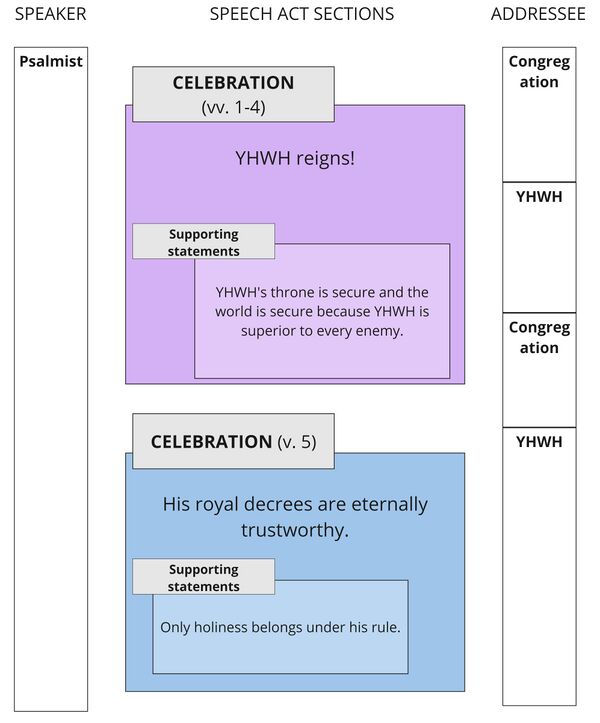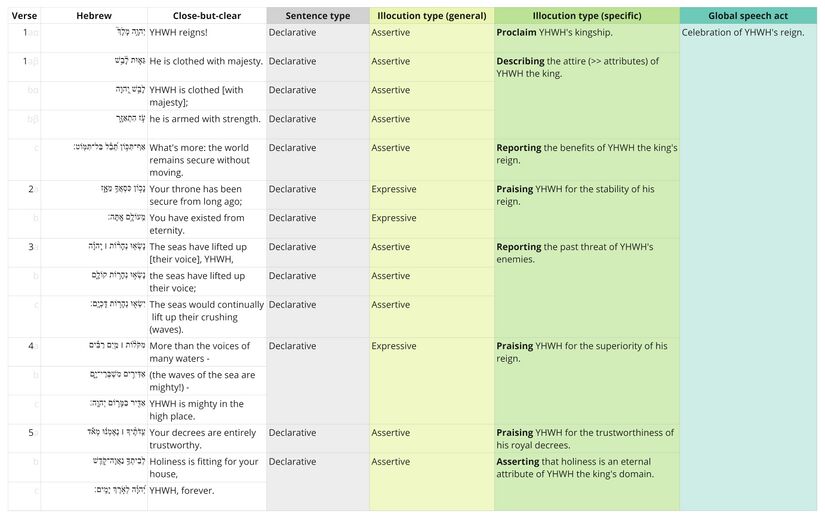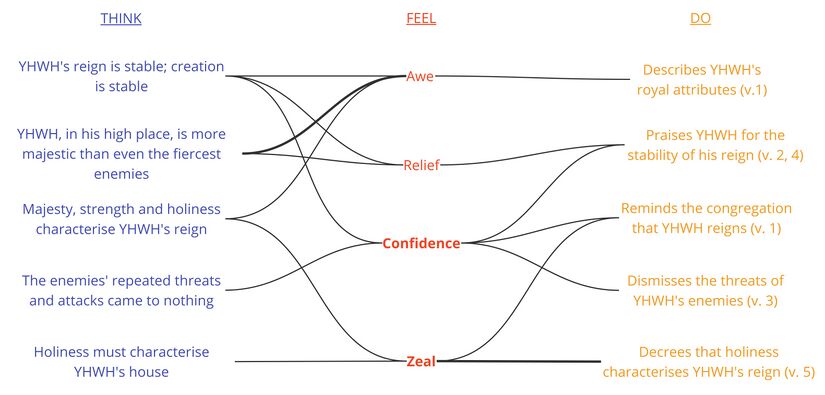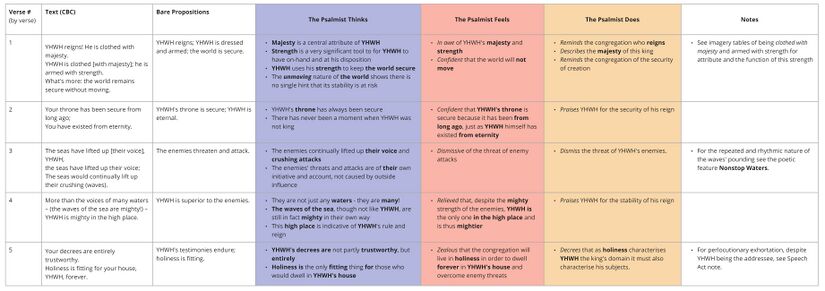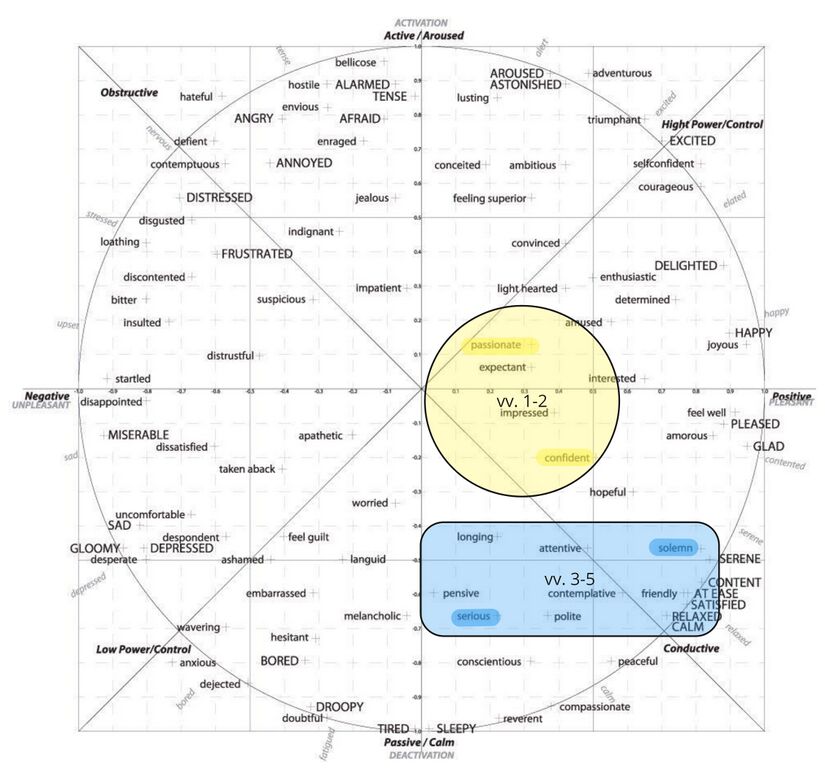Psalm 93 Discourse
About the Discourse Layer
Our Discourse layer includes four analyses: macrosyntax, speech act analysis, emotional analysis, and participant analysis. (For more information, click 'Expand' to the right.)
Macrosyntax
The macrosyntax layer rests on the belief that human communicators desire their addressees to receive a coherent picture of their message and will cooperatively provide clues to lead the addressee into a correct understanding. So, in the case of macrosyntax of the Psalms, the psalmist has explicitly left syntactic clues for the reader regarding the discourse structure of the entire psalm. Here we aim to account for the function of these elements, including the identification of conjunctions which either coordinate or subordinate entire clauses (as the analysis of coordinated individual phrases is carried out at the phrase-level semantics layer), vocatives, other discourse markers, direct speech, and clausal word order.
For a detailed explanation of our method, see the Macrosyntax Creator Guidelines.
Speech Act Analysis
The Speech Act layer presents the text in terms of what it does, following the findings of Speech Act Theory. It builds on the recognition that there is more to communication than the exchange of propositions. Speech act analysis is particularly important when communicating cross-culturally, and lack of understanding can lead to serious misunderstandings, since the ways languages and cultures perform speech acts varies widely.
For a detailed explanation of our method, see the Speech Act Analysis Creator Guidelines.
Emotional Analysis
This layer explores the emotional dimension of the biblical text and seeks to uncover the clues within the text itself that are part of the communicative intent of its author. The goal of this analysis is to chart the basic emotional tone and/or progression of the psalm.
For a detailed explanation of our method, see the Emotional Analysis Creator Guidelines.
Participant Analysis
Participant Analysis focuses on the characters in the psalm and asks, “Who are the main participants (or characters) in this psalm, and what are they saying or doing? It is often helpful for understanding literary structure, speaker identification, etc.
For a detailed explanation of our method, see the Participant Analysis Creator Guidelines.
Discourse Visuals for Psalm 93
Macrosyntax
Notes
Paragraph Divisions
- The opening line of the new paragraph is a thetic sentence (cf. v. 1a).
- v. 4's syntax slows down processing to the final words (the מִן standard of comparison preceding the comparee, the latter of which is found in its own specificational verbless clause with the climax of sentence-final YHWH appropriately in focus (see discussion above).
- v. 5's two clauses, likewise, both have fronted word order, each fronted constituent ending with 2ms suffixes.
Word Order
- v. 1a - The subject-fronted יְהוָ֣ה מָלָךְ֮ is famously thetic, initiating the entire discourse.
- v. 1b - As the king is established in 1a perhaps royal garments are activated, so לָ֫בֵ֥שׁ is accommodated and גֵּא֪וּת provides the focal selection of possible garments.
- v. 1d - As the king is established in 1a perhaps being armed is activated, so הִתְאַזָּ֑ר is accommodated and עֹ֣ז provides the focal selection of "armed with X."
- v. 2a - The initial predicate נָכ֣וֹן most likely provides a repetition with the same verbal root of v. 1e (תִּכּ֥וֹן). As a predicate-initial participial clause, this could either be read predicatively, and thus the fronted נָכ֣וֹן should be read as focal, or – in light of the repetition – specificationally, paraphrased as a cleft construction: the thing that is (also) in place is your throne. The latter seems preferable in the context of the psalm, so נָכ֣וֹן is not in bold.
- v. 2b - The fronted מֵֽעוֹלָ֣ם most likely provides a symmetrical pattern with the final מֵאָ֑ז of v. 2a, but can also function as scalar focus.
- v. 4β - The inversion of אַדִּירִ֣ים in the parenthetical verbless clause אַדִּירִ֣ים מִשְׁבְּרֵי־יָ֑ם causes similar beginnings continuity with v. 4γ, but can also be interpreted as confirming focus: believe it or not, the waves really are majestic.
- v. 4γ - The inversion of the adjective אַדִּ֖יר signals this verbless clause can be read as specificational, so The majestic one in the high place is YHWH ≈ YHWH is majestic in the high place, the line-final YHWH focal.
- v. 5a - The subject-fronted עֵֽדֹתֶ֨יךָ ׀ נֶאֶמְנ֬וּ מְאֹ֗ד is thetic, initiating the third discourse unit.
- v. 5b - The fronted לְבֵיתְךָ֥ activates a new topic, YHWH's house.
Vocatives
- v. 3a - In the backwards-gapped pair of vv. 3a-b, YHWH concludes the first clause to hold the floor and indicate more is coming.
- v. 5b - The clause-medial vocative both assists in delimiting lines phonologically and therefore correctly processing the syntax (Miller 2010: 360-363) and may focus the detached element as conversationally significant (Kim 2022: 227-233).
Discourse Markers
- The discourse marking אַף, scoping over its entire line, creates discontinuity.
- The new theme of stability (כון) follows, and is continued into the inverted participle נָכוֹן in 2a.
Speech Act Analysis
Summary Visual
Speech Act Chart
Emotional Analysis
Summary visual
Emotional Analysis Chart
Emotional Circumplex
Participant analysis
There are 4 participants/characters in Psalm 93:
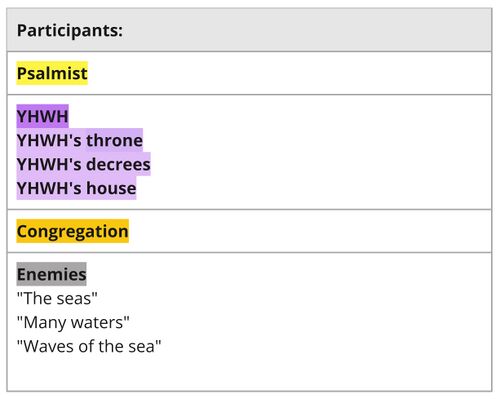
- The speaker is never identified so has simply been labelled psalmist.
- YHWH's throne, decrees and house have been identified as participants for two main reasons. First, they play an integral role in YHWH's reign, which the whole psalm seem to be about (v. 1a). Second, they are identified as secure (נָכ֣וֹן, v. 2a), trustworthy (נֶאֶמְנ֬וּ, v. 5a) and enduring (מֵאָ֑ז, v. 2a; לְאֹ֣רֶךְ יָמִֽים, v. 5b), just as the world is secure (v. 1e) thanks to YHWH's reign.
- The addressees of vv. 1, 4 are not explicitly identified so has been simply labelled congregation. Judah would also seem appropriate in the (probable) post-exilic Sitz im Leben of the psalm as forming an intentional part of book four of the Psalter (see Story Behind).
- For the seas' identification as enemies see Story Behind. Their powerful and chaotic nature is present in Ps. 24:1-2; 29:3, 10; their identification with the shouts of people in Ps. 65:8; and YHWH dominance over them in Pss. 24:1-2, 89:10-12 and 104:7-9. Though present in pre-creation-chaos mythology, the position of Ps 93 in Book 4 of the Psalter probably hints at their identity as those enemies following the fall of the Davidic line, i.e., the Babylonian invaders and ensuing exile.
Participant Relations Diagram
The relationships among the participants may be abstracted and summarized as follows:
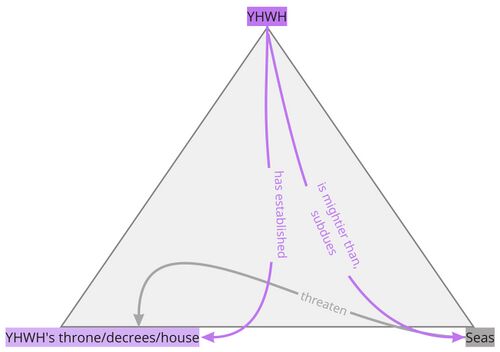

Participant Analysis Table
Notes
- vv. 1-4: The congregation or YHWH as the addressee(s)?
- Due to their lack of second person suffixes and vocatives (as seen in vv. 2-3, 5), the simplest (and thus preferred) interpretation seems to be a certain congregation or Judah, in general.
- Alternatively, since YHWH is clearly the addressee in vv. 2-3, 5, perhaps he should also be considered the addressee of vv. 1, 4, even though spoken of in the third person.
- For the seas' identification as enemies see Story Behind.

